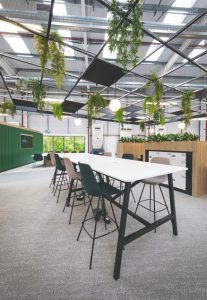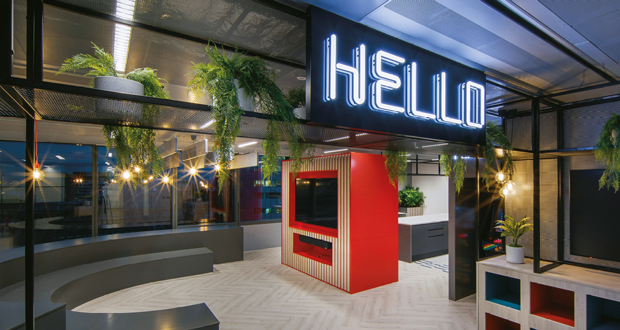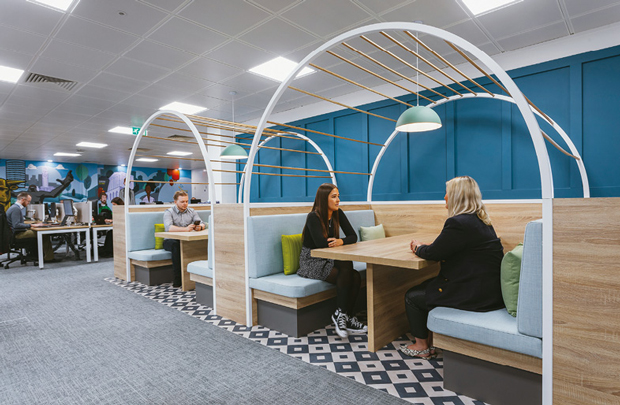 Patrick Ames, Design Director at Claremont, shares insights from Claremont’s research report – aptly titled The Workplace Oooh which sets out the feeling’s employees are searching for from their workplace and offers practical tips on how this can be achieved
Patrick Ames, Design Director at Claremont, shares insights from Claremont’s research report – aptly titled The Workplace Oooh which sets out the feeling’s employees are searching for from their workplace and offers practical tips on how this can be achieved
Facilities management has always been a varied role with busy professionals juggling the realities of buildings, facilities, services and user behaviours on a daily basis. But now, according to new research, facilities managers must also add feelings to their list of workplace concerns.
Research from nationwide workplace interior design and fit out business Claremont has identified the feelings that today’s employees want from the workplace experience. With work now seen as a task rather than a place, progressive employers are looking to the office to give employees the positive, branded, social and inspiring experiences they need to thrive. For facilities managers this presents a new list of operational considerations.
STATISTICAL INSIGHTS
Claremont commissioned Censuswide to survey more than 1,000 UK office workers across a range of sectors in January this year. The goal was to identify the impact of an office on a workforce’s positivity and productivity and to understand what employees need in order to feel happy, healthy and productive. The findings uncovered some surprising truths.
Almost half of employees – 52 per cent of hybrid workers and 48 per cent of full-time office-based workers – feel uninspired by their workplace, with 42 per cent saying their office doesn’t make them feel valued. At a time when employee engagement and retention is so crucial, this statistic is worrying. Workplaces need to be delivering much more.
The study also revealed that the vast majority of today’s employees (84 per cent) expect the office to deliver an experience, rather than just being a place to complete tasks and that nearly a third want a fun creative environment (30 per cent),  closely followed by brilliant technology (29 per cent).
closely followed by brilliant technology (29 per cent).
This suggests the office has to work much harder to make itself relevant and inviting – especially when many people could choose to stay working from home instead. Consequently, it must offer the feelings, tools and experiences that lone working leaves us wanting – those rich in face-to-face contact, collaboration and socialisation.
SIX KEY EMOTIONS
The Workplace Oooh Report reveals six key emotions that today’s employees seek from their workplace – they want to feel inspired, valued, connected, supported, included and proud.
Camaraderie and a feeling of connection with colleagues is key – over a third (35 per cent) of all employees and 42 per cent of hybrid workers said they want to visit the office to feel human connection; and teamwork is what makes people feel the most productive and positive about being in the office. This is perhaps not surprising with more and more people working remotely.
The power of personal connection came through strongly in the results too – with working as part of a team making almost a third of employees feel positive (32 per cent) about work and more productive (31 per cent). This need for the human touch was especially important for hybrid employees – 26 per cent of hybrid employees want to form friendships in the office (compared with 20 per cent of full-time office workers) and 42 per cent say the desire to feel connected makes them visit the office.
Crucially, the research also revealed the red flags that put people off attending the office – including poor kitchen facilities, poor and outdated office etiquette, lack of quiet spaces, no wellbeing spaces, concerns about cleanliness, no access to the outdoors and even bad coffee – all things under an FM’s remit.
The research findings have also tackled some important misconceptions about how the office is used. There’s a mistaken belief that since COVID the modern office is only about collaboration and team work. But it’s also sought out by employees because they want to feel they can concentrate and access quiet spaces. Our research proved that unreservedly.
Eighteen per cent of hybrid workers say they would be most likely to use the office for concentrated work and 14 per cent say they’d use it for quiet/lone working – compared with 40 per cent and 20 per cent of full-time office workers.
This research shows that employees’ feelings are governed by how much choice and control they have over the spaces they use, and that they need to be frictionless. Annoyance over how others behave in a shared kitchen, the inability to get the basics right like good quality refreshments, struggling to access shared resources like meeting rooms, or difficulties finding a quiet space to concentrate all create unnecessary friction. Friction erodes patience, goodwill, positivity and productivity and ultimately, discourages employees from visiting.






